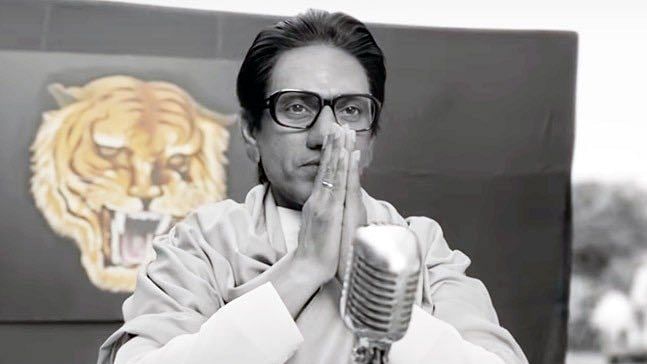Nawazuddin Siddiqui-starrer Thackeray is a propaganda film trying to rationalise the Shiv Sena leader’s ideology.
Thackeray, a biopic on Bal Thackeray, is loud, dramatic, and packed with edgy dialogues and intermittent violence—much like Bal Thackeray’s Shiv Sena.
Starring Nawazuddin Siddiqui and Amrita Rao, Thackeray is a propaganda film in the form of a biopic that comes just four months ahead of the Lok Sabha polls and attempts to rationalise Thackeray’s ideology through the various political and personal events in his life. At times, the film, directed by Abhijit Panse, seems to have a confused stance, a criticism that some political watchers have been hurling at today’s Shiv Sena too.
The film, produced by senior Shiv Sena leader and Rajya Sabha MP Sanjay Raut, brushes through the most controversial event in the leader’s life, his involvement in the 1992-93 Mumbai riots, and devotes more time in showing how he promised to help a Muslim family impacted by the riots and invited them to perform namaz at his residence, categorically saying that he does not indulge in politics of religion.
Yet, in another scene, Thackeray, known for his oratory, gives a rousing speech about the need for a government for the Hindus.
Also Read: To keep Thackeray alive, Shiv Sena must go beyond Balasaheb’s legacy
The film tries to show that the Shiv Sena grew out of a ‘sons of the soil’ agenda, but bears in mind that the Shiv Sena is today attempting to attract a more cosmopolitan population. Siddiqui in Thackeray’s garb tells ‘Indira Gandhi’ that he always says ‘Jai Hind’ first, ‘Jai Maharashtra’ later. That he respects the constitution of states and languages as India’s identity, and for him any person born in Maharashtra is Marathi.
In yet another scene, Thackeray is storming inside the Air India building at Mumbai’s Nariman Point, demanding jobs for locals and threatening the general manager.
In most of the film, Nawazuddin Siddiqui makes for a fairly convincing Thackeray,but in some scenes the actor’s personality comes through more strongly than Bal Thackeray’s. Amrita Rao, playing the leader’s wife, Meenatai Thackeray, does not have much of a role to speak of and wears a stoic and concerned expression in almost every scene that she is part of.
The movie runs for 139 minutes and quickly moves from one political event to another. Yet, in some moments, it comes across as lethargic, unable to hook the viewer despite its quick pace, filmy dialogues and theatrical background score. A large part of the film is in black and white.
The depiction of every incident in the life of Thackeray that is shown to have made him ‘Balasaheb’ from ‘Bal’ or framed his political ideology is accompanied with a tinge of drama.
For instance, a young Thackeray is shown watching a film soon after resigning from the Free Press Journal for not getting the journalistic freedom to say what he wants in his caricatures. He walks into a movie theatre, full of South Indians in lungis and Muslims wearing skull caps who enthusiastically applaud, as a cartoon film disses the ‘Marathi manoos.’
Also Read: I asked Balasaheb Thackeray, “Are you a mafioso?” — and lived to tell the tale
Similarly, the beginning of the 1992-93 riots is depicted with a toddler crying on the doorstep of a house minutes before an explosion right next to him. Soon after, swords and knives are wrapped in an old edition of Saamana, the Shiv Sena’s mouthpiece publication. The wrecking ball on the Babri Masjid is juxtaposed with the judge’s hammer.
All political references are direct. There are no subtleties. Thackeray shows the Shiv Sena supported the Emergency; that the party was once known as the A-team of the Maharashtra Congress when Vasantrao Naik was the CM and was even called ‘Vasant Sena’; that Communist Party of India (CPI) leader Krishna Desai was assassinated, and it was a ‘pratihalla’ (counter attack); that Thackeray supported Hitler’s ideology and did not believe in democracy, not even within his party.
The film spans over three decades, from the mid-1960s to the mid-1990s. It jumps from one event in the leader’s life to another, unfolding in chapters and culminating in the Shiv Sena forming its first government in Maharashtra and installing its first chief minister—Manohar Joshi.
The chapter is titled ‘sunrise’ and projected as a personal achievement of Thackeray, as most of Maharashtra’s map turns saffron and the leader revels in his personal success with his son, Uddhav Thackeray, and nephew, Raj Thackeray, on either side. Thackeray ends, promising a sequel.




The confusion / fog over the Shiv Sena’s political stance is slowly dissipating. The party has not pulled its ministers out of the central and state governments, although it criticises both and has declared its intent to fight the coming elections independently. Recent remarks underline its commitment to the NDA of which it is one of the oldest, steadfast members. Prudence dictates it will tie up with the BJP for both elections. What it is now saying is that it has an issue only with the current leadership, will be happy to participate in post election government formation.